|
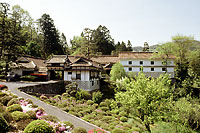
|
White
plaster walls and red roof tiles give this magnificent mansion,
which covers about 10,000 square meters, its distinctive appearance.
Said to date from the mid-Edo Period, it still today retains the
ambience of that era.
|

|
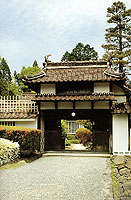
|
Tower
Gate
Even though the Nishie family were high-ranking village officials
(ojoya), few residences in Japan can boast an entrance
gate of such grandeur. This tower gate comprises two stories,
with a wood-floored room on the upper story.
|

|
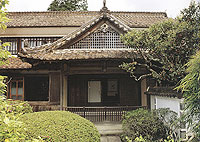
|
Entrance
(Genkan)
The main entrance was used exclusively for welcoming high-status
visitors (lords), and was ordinarily kept closed. Its impressive
roof resembles that of a Buddhist temple.
|

|
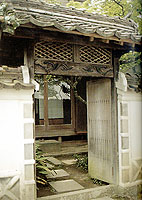
|
Gate
leading to Courtyard
Just past the gate is a courtyard spread with white gravel, which
served as a tribunal for judging petty crimes such as brawling
and gambling.
|

|
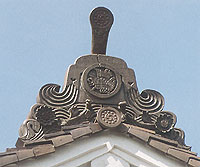
|
Onigawara
("Ogre tiles")
The decorative onigawara roof tiles are patterned with
swallowtail butterflies.
|

|
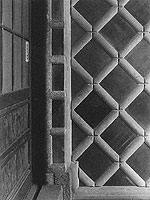
|
Namakokabe
(Tiled walls)
The walls on either side of the entrance to the earth-floored
part of the house are beautifully tiled with distinctive plasterwork.
The handiwork of skilled craftsmen, this is one of the finest
examples of namakokabe in Japan.
|

|
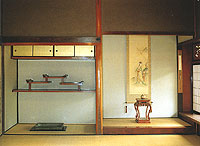
|
Reception
Room Alcove
The display shelves in the alcove (tokonoma) of the reception
room are arranged with an impeccable sense of harmony. Their beauty
is further enhanced by the warm tones of the bengara finish.
|

|
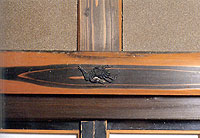
|
Many
of the interior pillars were finished with their bark left in
place, lending a rustic yet refined charm to the rooms.
|

|
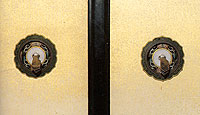
|
Sliding
Door Handles
The
handles on the fusuma (sliding doors) are highly ornate,
featuring exquisite cloisonne work. The fusuma frames are
of black lacquer.
|

|

|
A view of the five rooms beyond the doma (earth-floored part of
the house). The interplay of tatami mats and fusuma doors creates
a beautiful effect. This is a traditional floorplan seen in the
residences of high-ranking village officials (ojoya).
|

|
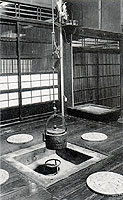
|
Area
around the sunken hearth (irori). On the central pillar
of the house is an altar to the kitchen god, known as Rokkuu-san.
|

|
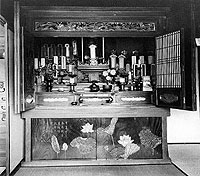
|
The
Buddhist family altar is handcarved with great dignity from keyaki
(zelkova) wood.
|


|



